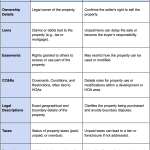Introduction
To read a title report, start by reviewing ownership details, liens, easements, and CC&Rs to confirm the property's legal status and identify potential risks.
Title Reports from Title Search Direct are organized and accurate and arrive in 3-7 days. Easy online ordering makes the process as simple as a few clicks.
How to Read a Title Report
What is a Title Report?
A title report is a document that outlines the legal status of a property.
It includes critical information such as ownership details, liens, easements, and restrictions tied to the property. Essentially, it confirms whether the seller has the right to sell and whether there are any potential legal or financial complications.
When buying a property, the title report serves as your safety net. It provides transparency, helping buyers uncover any red flags before the deal is finalized.
This document ensures nothing is overlooked.
Breakdown of Title Report Sections:
-
Ownership Details: Confirms the legal owner of the property.
-
Liens: Lists debts or claims against the property.
-
Easements: Rights allowing others limited property access.
-
CC&Rs: Rules tied to HOAs or developments.
How to Obtain a Title Report
Getting a title report is straightforward and essential for any property transaction.
Buyers can typically request one through a title company like Title Search Direct or with the help of their real estate agent.
It’s a key step in the due diligence process to avoid any unwelcome surprises down the road.
Steps to Obtain a Title Report
-
Work with a trusted title company.
-
Request a preliminary title report during due diligence.
-
Collaborate with real estate agents or attorneys to obtain one.
-
Double-check all details and resolve discrepancies if needed.
Important Sections of a Title Report Explained
Ownership Details
The ownership section confirms who legally owns the property.
It’s your assurance that the seller has the legal right to transfer the title. Any discrepancies here can halt a sale, so it’s a section you’ll want to review closely.
Liens
Liens are claims or debts attached to the property.
Common examples include tax liens, mortgage liens, and mechanic’s liens.
A tax lien occurs when property taxes haven’t been paid, while a mortgage lien is tied to a home loan. Each lien represents a financial obligation that must be settled before the property can change hands.
Overlooking liens can lead to costly surprises. Always pay close attention to this section of the report.
Easements
Easements grant others specific rights to access or use parts of the property. For instance, a utility company may have an easement to run power lines. While often harmless, easements can restrict certain types of property use.
CC&Rs
CC&Rs (Covenants, Conditions, and Restrictions) are rules often tied to properties within HOAs or planned developments. They can dictate everything from fence height to paint colors. While they help maintain neighborhood standards, they can also limit your freedom to make changes to the property.
Common Issues Found in a Title Report
A title report can uncover issues that may delay or derail a property transaction. Buyers often encounter red flags that require immediate attention to avoid costly mistakes down the line.
These issues typically involve financial claims, ownership disputes, or restrictions tied to the property. Understanding these potential pitfalls helps buyers make informed decisions before moving forward.
Potential Issues to Look For:
-
Unpaid property taxes: Outstanding taxes can create a lien on the property, which the buyer might inherit.
-
Unknown liens or legal claims: Debts or obligations tied to the property can affect its value and transferability.
-
Conflicting ownership claims: Discrepancies in ownership records can result in legal disputes.
-
Restrictions under CC&Rs: HOA-imposed rules may limit what you can do with the property.
Why Understanding a Title Report is Critical
Skipping a review of the title report can lead to significant financial and legal risks.
Imagine buying a home only to discover it comes with unpaid taxes or unresolved legal claims.
That’s not a surprise anyone wants.
A thorough understanding of the report lets buyers uncover potential risks.
Hidden easements are another common issue. For instance, a utility company might have rights to part of the property, restricting how you can use it.
Tips for Reading a Title Report
Reading a title report is simple when you know what to expect.
Start with the basics and work your way through the document.
Tips for Beginners:
-
Familiarize yourself with key terms like liens, easements, and CC&Rs to better understand what you’re reviewing.
-
Focus on ownership, financial, and use-related sections to spot potential issues quickly.
-
Seek clarification for unclear entries by consulting the title company or professionals involved in the process.
-
Consult with a title professional or attorney to confirm all findings and address any concerns.
How Title Search Direct Can Help You
Title Search Direct delivers precise, reliable title reports to help you make confident decisions.
Our expert team handles every detail. Whether you’re buying, selling, or managing property, they’re here to simplify the process with their professional, accurate services.
Final Thoughts: Understanding Title Reports for Successful Property Transactions
Reviewing a title report is one of the smartest steps you can take when buying property.
It protects you from unexpected liabilities and gives you peace of mind. This document is your roadmap to a successful transaction, from identifying unpaid taxes to understanding easements.
With Title Search Direct, you get every piece of information you need in an accurate and organized property title report. We deliver within 3-7 days and serve the entire lower 48. Order today!





